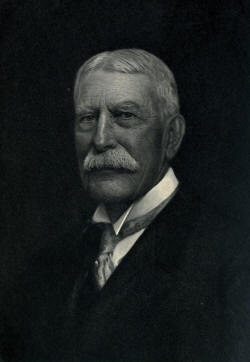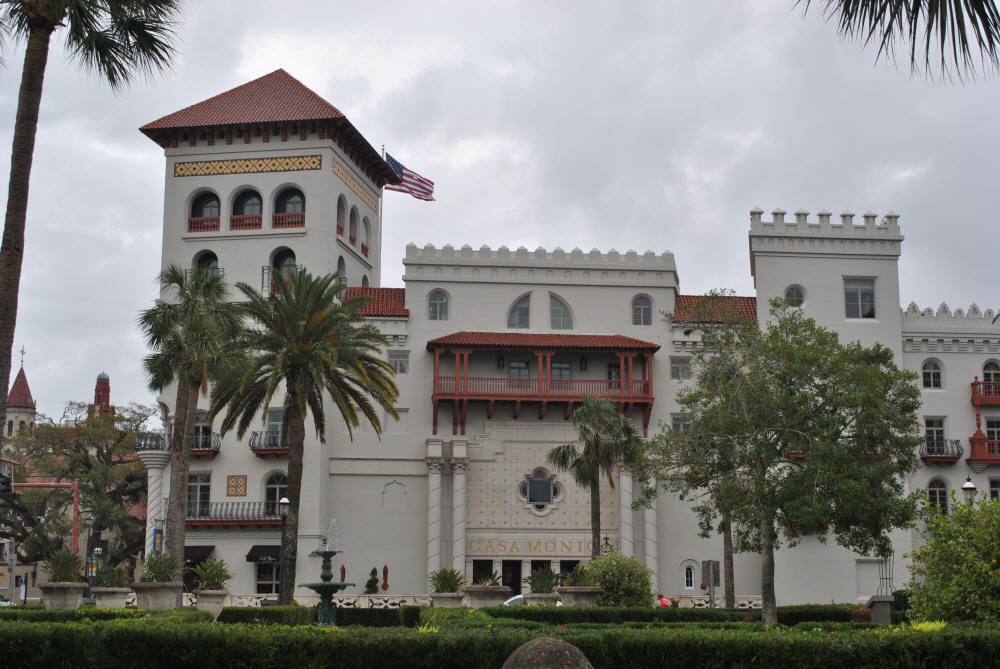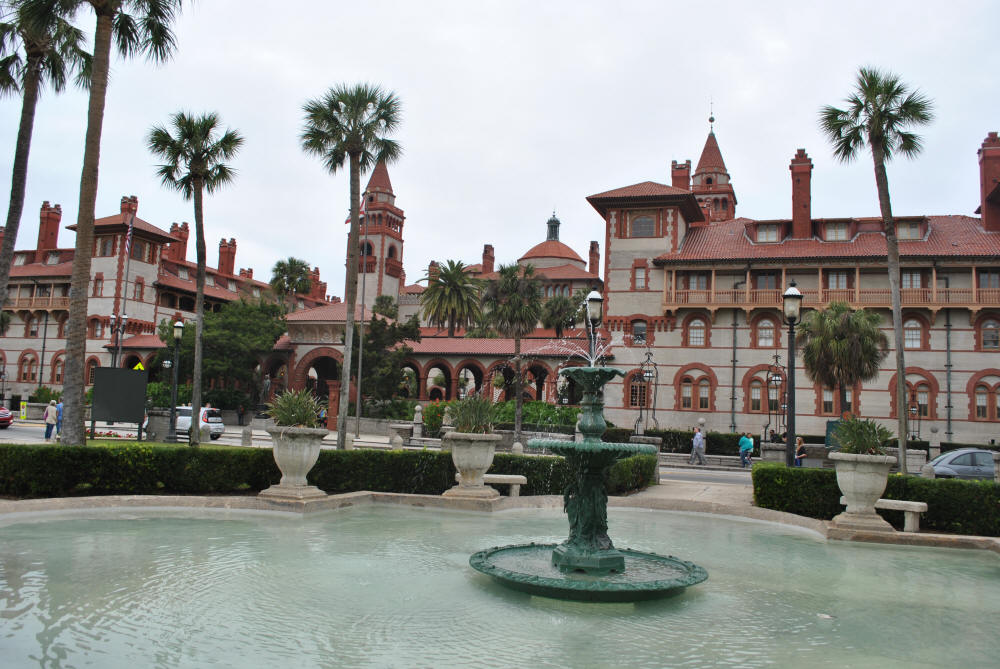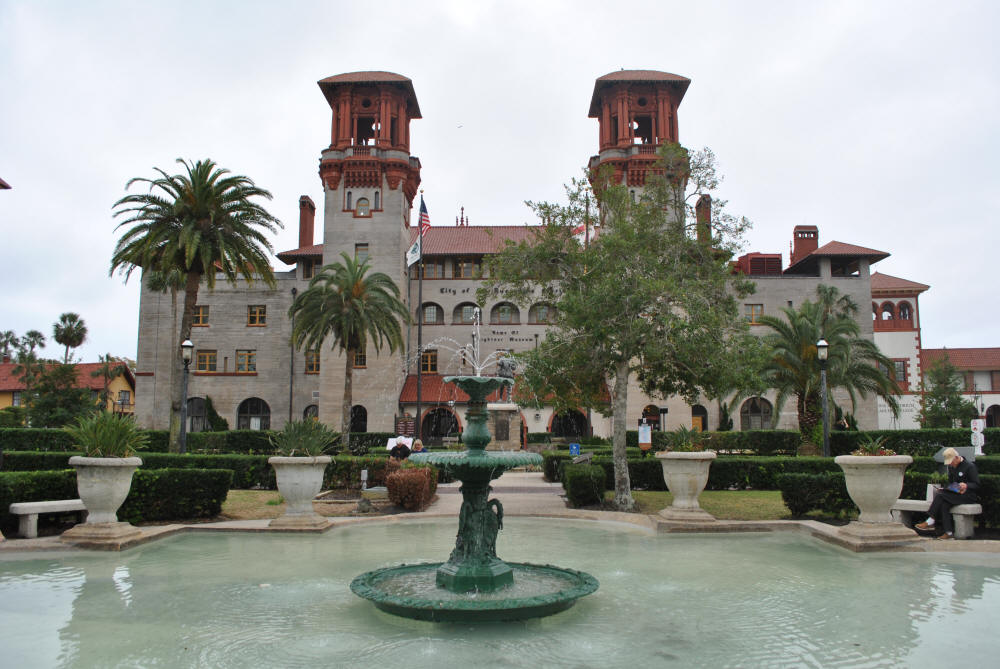Queer Places:
Casa Monica Hotel, 95 Cordova St, St Augustine, FL 32084
Ponce De Leon Hotel, 74 King Street, St Augustine, FL 32084
Lightner Museum, 75 King Street, St Augustine, FL 32084
The Breakers, 1 S County Rd, Palm Beach, FL 33480
Whitehall, 1 Whitehall Way, Palm Beach, FL 33480
Memorial Presbyterian Church and Columbarium
Saint Augustine, St. Johns County, Florida, USA
 Henry Morrison Flagler (January 2, 1830 – May 20, 1913) was an American industrialist and a founder of Standard Oil, which was first based in Ohio. He was also a key figure in the development of the Atlantic coast of Florida and founder of the Florida East Coast Railway. He is also known as a founder of the cities of Miami and Palm Beach, Florida.[1]
He was a member of the
Horace Walpole Society.
Harry Harkness Flagler was his son.
Henry Morrison Flagler (January 2, 1830 – May 20, 1913) was an American industrialist and a founder of Standard Oil, which was first based in Ohio. He was also a key figure in the development of the Atlantic coast of Florida and founder of the Florida East Coast Railway. He is also known as a founder of the cities of Miami and Palm Beach, Florida.[1]
He was a member of the
Horace Walpole Society.
Harry Harkness Flagler was his son.
Flagler was born in Hopewell, New York. His father was Isaac Flagler, a Presbyterian minister and great-grandson of Zacharra Flegler, whose family had emigrated from the German Palatinate region to Holland in 1688. Zacharra worked in England for several years before moving to Dutchess County, New York, in 1710. His grandson Solomon changed the spelling of the surname to Flagler and passed it on to his 11 children.[2] Flagler's mother was Elizabeth Caldwell Harkness Flagler, Isaac's third wife and a widow who had a stepson, Stephen V. Harkness, and a son, Daniel M. Harkness, from her marriage to deceased widower David Harkness of Milan, Ohio.[3]
Flagler attended local schools through eighth grade. His half-brother Daniel had left Hopewell to live and work with his paternal uncle Lamon G. Harkness, who had a store in Republic, Ohio. He recruited Henry Flagler to join him, and the youth went to Ohio at age 14, where he started work in 1844 at a salary of US$5 per month plus room and board. By 1849, Flagler was promoted to the sales staff at a salary of $40 per month. He later joined Daniel in a grain business started with his uncle Lamon in Bellevue, Ohio.
In 1862, Flagler and his brother-in-law Barney Hamlin York (1833–1884) founded the Flagler and York Salt Company, a salt mining and production business in Saginaw, Michigan. He found that salt mining required more technical knowledge than he had and struggled in the industry during the Civil War. The company collapsed when the war undercut commercial demand for salt. Flagler returned to Bellevue having lost his initial $50,000 investment and an additional $50,000 he had borrowed from his father-in-law and Daniel. Flagler believed that he had learned a valuable lesson: invest in a business only after thorough investigation.[4]

Casa Monica Hotel

Ponce De Leon Hotel

Lightner Museum

The Breakers

Whitehall
When Flagler's first wife Mary Harkness fell sick, his physician recommended they travel to Jacksonville for the winter to escape the brutal conditions of the North. For the first time, Flagler was able to experience the warm, sunny atmosphere of Florida. Two years after his first wife died in 1881, he married again. Ida Alice Shourds had been a caregiver for Mary. After their wedding, the couple traveled to Saint Augustine. Flagler found the city charming, but the hotel facilities and transportation systems inadequate. Franklin W. Smith had just finished building Villa Zorayda and Flagler offered to buy it for his honeymoon. Smith would not sell, but he planted the seed of St. Augustine's and Florida's future in Flagler's mind.[44]
Although Flagler remained on the board of directors of Standard Oil, he gave up his day-to-day involvement in the corporation to pursue his interests in Florida. He returned to St. Augustine in 1885 and made Smith an offer. If Smith could raise $50,000, Flagler would invest $150,000 and they would build a hotel together. Perhaps fortunately for Smith, he couldn't come up with the funds,[45] so Flagler began construction of the 540-room Ponce de Leon Hotel by himself, but spent several times his original estimate. Smith helped train the masons on the mixing and pouring techniques he used on Zorayda.[46] Realizing the need for a sound transportation system to support his hotel ventures, Flagler purchased short line railroads in what would later become known as the Florida East Coast Railway. He used convict leasing — "a method undertaken by the Southern States to replace the economic setup of slavery"[47] — to modernize the existing railroads, allowing them to accommodate heavier loads and more traffic.[48]
His next project was the Ponce de Leon Hotel, now part of Flagler College. He invested with the guidance of Dr. Andrew Anderson, a native of St. Augustine. After many years of work, it opened on January 10, 1888, and was an instant success. This project sparked Flagler's interest in creating a new "American Riviera." Two years later, he expanded his Florida holdings. He built a railroad bridge across the St. Johns River to gain access to the southern half of the state and purchased the Hotel Ormond, just north of Daytona. He also built the Alcazar Hotel as an overflow hotel for the Ponce de Leon Hotel. The Alcazar is today the Lightner Museum, next to the Casa Monica Hotel in St. Augustine that Flagler bought from Franklin W. Smith. His personal dedication to the state of Florida was demonstrated when he began construction on his private residence, Kirkside, in St. Augustine.
An immense engineering effort was required to cut through the wilderness and marsh from St. Augustine to Palm Beach. The state provided incentive in the form of 3,840 acres (15.5 km2) for every mile (1.6 km) of track constructed.[49]
Flagler completed the 1,100-room Royal Poinciana Hotel on the shores of Lake Worth in Palm Beach and extended his railroad to its service town, West Palm Beach, by 1894, founding Palm Beach and West Palm Beach.[1] The Royal Poinciana Hotel was at the time the largest wooden structure in the world. Two years later, Flagler built the Palm Beach Inn (renamed The Breakers in 1901), overlooking the Atlantic Ocean in Palm Beach.
Flagler originally intended West Palm Beach to be the terminus of his railroad system, but in 1894 and 1895, severe freezes hit the area, causing Flagler to reconsider. Sixty miles (97 km) south, the area today known as Miami was reportedly unharmed by the freeze. To further convince Flagler to continue the railroad to Miami, he was offered land in exchange for laying rail tracks from private landowners, the Florida East Coast Canal and Transportation Company, and the Boston and Florida Atlantic Coast Land Company. The land owners were Julia Tuttle, whom he had met in Cleveland, Ohio, and William Brickell, who ran a trading post on the Miami River.
Such incentive led to the development of Miami, which was an unincorporated area at the time. Flagler encouraged fruit farming and settlement along his railway line and made many gifts to build hospitals, churches and schools in Florida.
By 1896, Flagler's railroad, the Florida East Coast Railway, reached Biscayne Bay. Flagler dredged a channel, built streets, instituted the first water and power systems, and financed the city's first newspaper, The Metropolis. When the city was incorporated in 1896, its citizens wanted to honor the man responsible for its growth by naming it "Flagler". He declined the honor, persuading them to use an old Indian name, "Mayaimi". Instead, an artificial island was constructed in Biscayne Bay called Flagler Monument Island. In 1897, Flagler opened the exclusive Royal Palm Hotel on the north bank of the Miami River where it overlooked Biscayne Bay. He became known as the Father of Miami, Florida.
Flagler's second wife, Ida Alice Shourds, was declared insane[50] by Flagler's friend Dr. Anderson in 1896 and was institutionalized on and off starting that year. At the same time, he began to have an affair with Mary Lily Kenan; by 1899, newspapers began to openly question whether the two were having an affair. That year he reportedly gave her more than $1 million in jewelry.[51] In 1901, Flagler bribed the Florida Legislature and Governor to pass a law that made incurable insanity grounds for divorce, opening the way for Flagler to remarry. Flagler was the only person to be divorced under the law before it was repealed in 1905.[52] A spouse's mental incapacity was later restored by the legislature as a grounds for dissolution of marriage, and remains the law of Florida today.[53]
On August 24, 1901, 10 days after his divorce, Flagler married Mary Lily at her family's plantation, Liberty Hall, and the couple soon moved into their new Palm Beach estate, Whitehall, a 55-room beaux arts home designed by the New York-based firm of Carrère and Hastings, which also had designed the New York Public Library and the Pan-American Exposition.[54] Built in 1902 as a wedding present to Mary Lily, Whitehall (now the Flagler Museum) was a 60,000-square-foot (5,600 m²) winter retreat that established the Palm Beach "season" of about 8–12 weeks, for the wealthy of America's Gilded Age. By 1905, Flagler decided that his Florida East Coast Railway should be extended from Biscayne Bay to Key West, a point 128 miles (206 km) past the end of the Florida peninsula. At the time, Key West was Florida's most populous city, with a population of 20,000, and it was also the United States' deep water port closest to the canal that the U.S. government proposed to build in Panama. Flagler wanted to take advantage of additional trade with Cuba and Latin America as well as the increased trade with the west that the Panama Canal would bring.
In 1912, the Florida Overseas Railroad was completed to Key West. Over 30 years, Flagler had invested about $50 million in railroad, home and hotel construction and had made donations to suffering farmers after the freeze in 1894. When asked by the president of Rollins College in Winter Park about his philanthropic efforts, Flagler reportedly replied, "I believe this state is the easiest place for many men to gain a living. I do not believe any one else would develop it if I do not..., but I do hope to live long enough to prove I am a good business man by getting a dividend on my investment."[55]
In March 1913, Flagler fell down a flight of marble stairs at Whitehall. He never recovered and died in Palm Beach of his injuries on May 20, 1913 at 83 years of age.[60][61] At 3 p.m. on the day of the funeral, May 23, 1913, every engine on the Florida East Coast Railway stopped wherever it was for ten minutes as a tribute to Flagler. It was reported that people along the railway line waited all night for the passing of the funeral train as it traveled from Palm Beach to St. Augustine.[62]
Flagler was entombed in the Flagler family mausoleum at Memorial Presbyterian Church in St. Augustine alongside his first wife, Mary Harkness; daughter, Jenny Louise; and granddaughter, Marjorie. Only his son Harry Harkness Flagler survived of the three children by his first marriage in 1853 to Mary Harkness. A large portion of his estate was designated for a "niece" who was said actually to be a child born out of wedlock.
When looking back at Flagler's life, after Flagler's death, George W. Perkins, of J.P. Morgan & Co., reflected, "But that any man could have the genius to see of what this wilderness of waterless sand and underbrush was capable and then have the nerve to build a railroad here, is more marvelous than similar development anywhere else in the world."[63]
Miami's main east-west street is named Flagler Street and is the main shopping street in Downtown Miami. There is also a monument to him on Flagler Monument Island in Biscayne Bay in Miami; Flagler College and Flagler Hospital are named after him in St. Augustine. Flagler County, Florida, Flagler Beach, Florida and Flagler, Colorado are also named for him. Whitehall, Palm Beach, is open to the public as the Henry Morrison Flagler Museum; his private railcar No. 91 is preserved inside a Beaux Arts pavilion built to look like a 19th-century railway palace.[64]
On February 24, 2006, a statue of Flagler was unveiled in Key West near the spot where the Over-Sea Railroad once terminated. Also, on July 28, 2006, a statue of Flagler was unveiled on the southeast steps of Miami's Dade County Courthouse, located on Miami's Flagler Street.
The Overseas Railroad, also known as the Key West Extension of the Florida East Coast Railway, was heavily damaged and partially destroyed in the Labor Day Hurricane of 1935. The railroad was financially unable to rebuild the destroyed sections, so the roadbed and remaining bridges were sold to the State of Florida, which built the Overseas Highway to Key West, using much of the remaining railway infrastructure.
Flagler's third wife, Mary Lily Kenan Flagler Bingham was born in North Carolina. The top-ranked Kenan-Flagler Business School at the University of North Carolina at Chapel Hill is named for Flagler and his wife, who was an early benefactor of UNC along with her family and descendants.[65] After Flagler's death, she married an old friend, Robert Worth Bingham, who used an inheritance from her to buy the Louisville Courier-Journal newspaper. The Bingham-Flagler marriage (and questions about her death or possible murder) figured prominently in several books that appeared in the 1980s, when the Bingham family sold the newspaper in the midst of great acrimony. Control of the Flagler fortune largely passed into the hands of Mary Lily Kenan's family of sisters and brother, who survived into the 1960s.
My published books:


BACK TO HOME PAGE

 Henry Morrison Flagler (January 2, 1830 – May 20, 1913) was an American industrialist and a founder of Standard Oil, which was first based in Ohio. He was also a key figure in the development of the Atlantic coast of Florida and founder of the Florida East Coast Railway. He is also known as a founder of the cities of Miami and Palm Beach, Florida.[1]
He was a member of the
Horace Walpole Society.
Harry Harkness Flagler was his son.
Henry Morrison Flagler (January 2, 1830 – May 20, 1913) was an American industrialist and a founder of Standard Oil, which was first based in Ohio. He was also a key figure in the development of the Atlantic coast of Florida and founder of the Florida East Coast Railway. He is also known as a founder of the cities of Miami and Palm Beach, Florida.[1]
He was a member of the
Horace Walpole Society.
Harry Harkness Flagler was his son.





